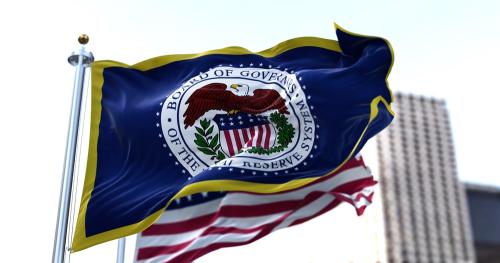Mr. Chairman and Members of the subcommittee:
You have before you a long list of proposed legislative changes applying to the Federal Reserve, some of which would make important changes in the character of the institution, its policy processes, and its authorities. At the same time you are also considering the formation of a commission to examine whether indeed the Federal Reserve should be altered to make it a more effective institution. The basic premise of both of these strands is that something has been seriously amiss with the way the Federal Reserve has carried out the responsibilities Congress has given it.
I do not agree with that premise. In my view, the actions of the Federal Reserve in the crisis and slow recovery were necessary and appropriate. Its conduct of monetary policy has been as systematic as possible under unprecedented and constantly evolving circumstances, and it has been especially transparent about how those monetary policy actions were expected to foster achievement of its legislated mandate and what it would be looking at in the future to gauge the need for future actions. The Federal Reserve, working in part under the guidance of the Congress in Dodd Frank, has greatly toughened and improved its regulation and supervision of the institutions for which it is responsible, and the financial system is safer than it has been for many years.
No institution is perfect. Circumstances change, lessons are learned, and all policy institutions must adapt if they are to continue to serve the public interest as well as possible. You are right to be asking tough questions about whether further improvements in the Federal Reserve’s performance as well as your oversight and the Fed’s accountability are possible, and the extent to which new legislation is needed to make those changes. In my view, however, the suggestions in the proposed legislation, as I weigh their costs and benefits, are not likely to improve the Federal Reserve’s performance and enhance the public interest, and could very well harm it.
Congress has established goals for monetary policy, given the experts at the Federal Reserve insulation from short-term political pressures to set their policy instruments to meet those goals, and then held the Federal Reserve accountable for the outcomes. The Senate, in its role in appointments to the Federal Reserve Board, has a critical say in making sure the right experts are in place to carry out this responsibility. You have recognized that this model of independent but accountable central banking has proven to work better in the public interest than one in which political pressures can be brought more forcefully to bear on the central bank instrument settings. I urge you to keep the current balance in place.
Let me address just a few of the proposals.
Policy Rules and GAO audits. Being as systematic, predictable, and transparent as possible about what the Federal Reserve is doing increases the effectiveness of monetary policy because it helps private market participants accurately anticipate Federal Reserve actions. It also enhances your ability to assess the policy strategies of the FOMC. The Federal Reserve should explain why it has chosen the instrument settings it has, how those settings are expected to foster achievement of their responsibilities, and on what basis they might evolve in the future. The FOMC has taken a number of steps to increase the predictability and transparency of its actions, especially over the past 10 years.
But “as possible” is the key phrase in that first sentence of the previous paragraph. The Federal Reserve, the Congress, and private market participants must recognize the limits of our knowledge of economic relationships, including the relationship between changes in policy instrument settings and progress toward the Federal Reserve’s legislated objectives. The U.S. economy is a complex and ever-changing system that cannot be comprehensively summarized in a few variables and empirical relationships. Not only are the relationships imperfectly understood and evolving, but unexpected developments here and around the world can affect the U.S. economy.
The result is that the Federal Reserve must use all available information that might shed light on evolving economic relationships and the effects of policy, and use it in a flexible manner. Statistical economic models relating future inflation, economic activity, and labor market slack to incoming information about the economy and to financial variables have proven especially unreliable over the past eight years of financial market disruption; history has been a poor guide to the future in these unprecedented circumstances. Models and policy rules can be useful inputs for policy, but they are only inputs and cannot be relied on as hard guides to policy settings to achieve the Federal Reserve’s objectives.
To be sure, policy has taken unexpected steps over the past seven years, but this was in response to unexpected developments. Moreover, the recovery from the financial crisis was disappointingly slow. But it would have been even slower had the FOMC not undertaken unconventional and sometimes unexpected policy actions. The pricing of actual and expected volatility in financial markets has not suggested an unusual amount of uncertainty about the path of interest rates or the Federal Reserve’s portfolio holdings going forward.
Requiring the Federal Reserve to send you a rule that includes “a function that comprehensively models the interactive relationship between intermediate policy inputs” and “the coefficients of the directive policy rule that generate the current policy instrument target” would be at best a useless exercise for you, the Federal Reserve, and the American public and could well prove counterproductive for achieving goals and understanding strategies. If it is adhered to it will produce inferior results; if it is not, as I would hope and expect, it would be misleading.
If the Federal Reserve were to frequently alter and deviate from policy rules you would require it to publish under the proposal, as I expect it would, then the GAO would be frequently second guessing FOMC decisions. Indeed, under another section of the proposed legislation the exemption for monetary policy from GAO audit would be repealed.
Congress was wise to differentiate monetary policy from other functions of the Federal Reserve in 1978 when it authorized GAO audits of those other functions. It recognized that the GAO audits could become an avenue for bringing political pressure on the FOMC’s decisions on the setting of its policy instruments. Around the same time, Congress clarified the objectives for policy and it established reports and hearings to hold the Federal Reserve accountable for achieving those objectives. It also recognized that over time and across countries, experience suggested that when monetary policy is subject to short-term political pressures, outcomes are inferior; in particular inflation tends to be higher and more variable.
In that context, the extra pressure of GAO audits of policy decisions moves the needle in the wrong direction. At some point, and I hope before too long, the labor market will be strong enough and the prospects for inflation to rise will be good enough that the Federal Reserve will begin to tighten policy to avoid overshooting its two percent inflation target. That will not be popular with some political observers. The Congress made a good decision in 1978 and I urge you to stick with it and find other ways to inform your oversight of monetary policy.
Changes to emergency lending powers for nonbanks. Supplying liquidity to financial institutions by lending against possibly illiquid collateral is a key function of central banks. Indeed, having an institution to do this in the U.S. was a major impetus behind Congress establishing the Federal Reserve in 1913. When confidence in financial institutions erodes and uncertainty about whether they can repay the funds they borrowed increases, they experience runs—those supplying funds to banks and other intermediaries stop. Without a backup source of funding, lenders are forced to stop making loans and to sell assets in the market at any price. The resulting drying up of credit and fire sale of assets severely harms the ability of households and businesses to borrow and spend and can result in deep recessions with high unemployment. Borrowing from a central bank under such circumstances helps lenders continue to meet the credit needs of households and businesses; it is an essential way for the central bank to cushion Main Street from the loss of confidence in the financial sector.
For most of the twentieth century the Federal Reserve could perform that function adequately by lending to commercial banks and other depositories. But in the past few decades, intermediation in the U.S. has shifted from banks to securities and securitization markets. In 2008, the Federal Reserve found that lending to nonbanks—to investment banks, money market funds, buyers of securitizations—was required to stem the panic and limit the damage to Main Street. Some of what we did, however necessary, was uncomfortable—in particular lending to support individual troubled institutions, like AIG, or to support of the acquisition of Bear Stearns. The Federal Reserve supported giving the FDIC an alternative method of dealing with troubled financial institutions and limiting the use of the discount window for nonbanks to facilities that would be widely available to institutions caught up in the panic.
Congress made those changes on lending to nonbanks in Dodd-Frank and added a few more on reporting, collateral, and approval by the secretary of the Treasury. I would not go further; in fact I’m concerned that some of what you have already done might limit the effectiveness of the Federal Reserve’s lender of last resort function for a twenty-first century financial market—make panics even harder to stop and raise the risk that households and businesses would lose access to credit. The restrictions you have already placed on 13-3 lending, the resolution authority you have given to the FDIC, and the higher capital requirements on systemically important institutions are in the process of eliminating the moral hazard of any remaining perceived benefit from nonbank access to lender of last resort.
We need to keep in mind that difficult judgments are required in such a situation—especially about solvency and collateral valuations. The nature of a financial crisis is that the line between liquidity problems and solvency problems is not clear—institutions that might be insolvent if their assets were sold at fire sale prices might be comfortably solvent when the panic subsides; collateral whose value has dropped sharply in the panic will recover as the panic subsides. Central banks need to be able to make such judgment calls quickly—and explain them to the public—and they need to be sure not to add to market problems by chasing collateral values down or judging otherwise sound institutions as insolvent.
The Monetary Commission. As I said at the beginning of my testimony, no institution is perfect; all need to learn lessons and adapt. The Federal Reserve has been adapting its monetary policy strategy and communications. The Federal Reserve, the other regulators, and the Congress have addressed many of the deficiencies in regulation and supervision that allowed the circumstances that led to the crisis to build.
As I also noted, I do not believe that major changes have been identified that would make the Federal Reserve a significantly more effective public policy institution. But I recognize that the geographical structure of the System was set in 1914; some of the relationships among its constituent parts, including the make-up of the monetary policy committee, in the 1930s; and its monetary policy goals and reporting in the late 1970s. I cannot rule out that a group of thoughtful policy experts might be able to suggest some further improvements to goals, structure, and decision-making processes.
But the proposal before us has a panel rooted in partisan politics, not expertise, and its make-up is strongly tilted to one side. It has in effect pre-judged one aspect of the conclusions by mandating that a reserve bank president be included, but not a member of the board of governors. Shifting authority from the Board to the presidents is a general theme of many of the proposals before us and as a citizen I find it troubling. The reserve banks and their presidents make valuable contributions to the policy process; in particular they bring a greater diversity of views than is often found on the board of governors. But they are selected by private boards of directors, to be sure with the approval of the board of governors, and giving them greater authority would in my view threaten the perceived democratic legitimacy of the Federal Reserve over time.
The Congress has given the Federal Reserve Board, with its members appointed by the president and approved by the senate, a clear majority on the FOMC, even when there might be a vacancy on the Board. And it has given the Board authority over discount window lending by the reserve banks as well as their operations. I believe that public support for the Federal Reserve in our democratic society requires that the authority of the Board not be eroded.



Commentary
TestimonyExamining Federal Reserve reform proposals
July 22, 2015